Analysis of Family Violence and Welfare Systems in Australia
VerifiedAdded on 2023/06/03
|8
|2334
|114
Report
AI Summary
This report provides a comprehensive analysis of family violence in Australia, examining its prevalence, risk factors, and impact on individuals, particularly women and children. It delves into the existing welfare systems and services designed to address and prevent family violence, including government initiatives and community programs. The report explores the causes of family violence, including social and economic factors, and discusses the effectiveness of various prevention strategies at primary, secondary, and tertiary levels. Furthermore, it incorporates a reflection on the author's learning and understanding of the issue, highlighting gaps in service provision and suggesting areas for improvement within the welfare system. The report concludes with an overview of the issue, emphasizing the importance of a multi-faceted approach to tackling family violence in Australia.
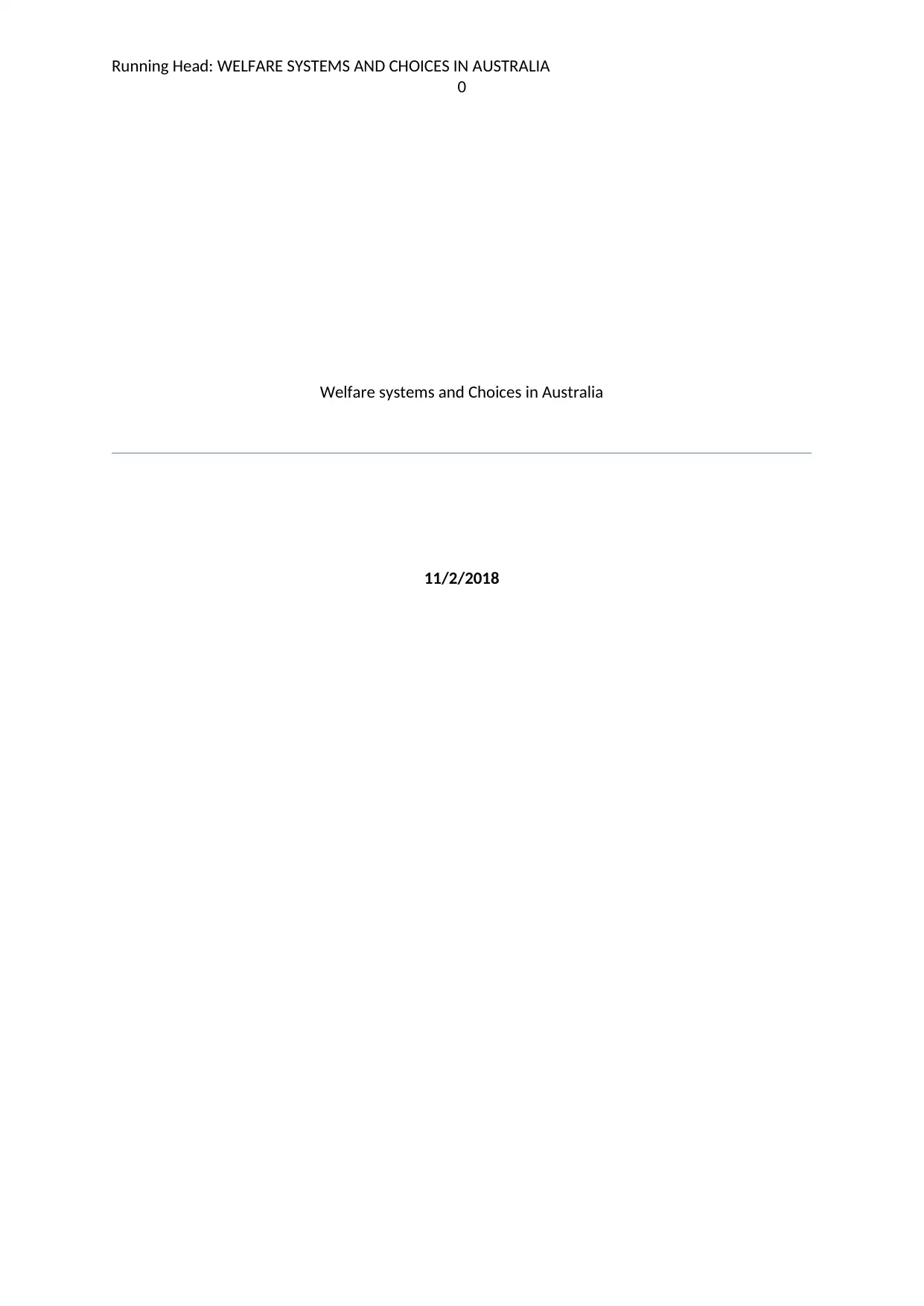
Running Head: WELFARE SYSTEMS AND CHOICES IN AUSTRALIA
0
Welfare systems and Choices in Australia
11/2/2018
0
Welfare systems and Choices in Australia
11/2/2018
Paraphrase This Document
Need a fresh take? Get an instant paraphrase of this document with our AI Paraphraser
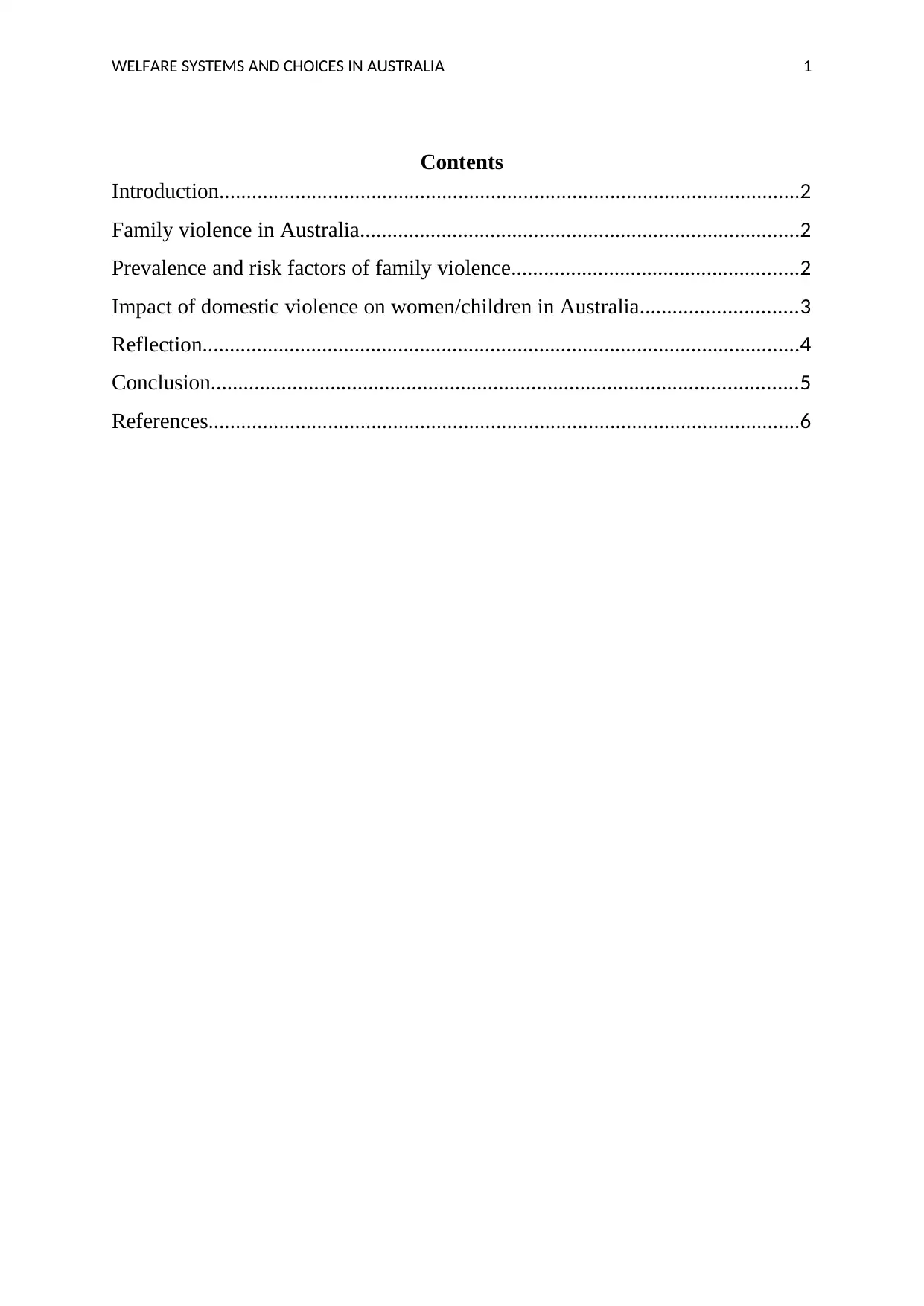
WELFARE SYSTEMS AND CHOICES IN AUSTRALIA 1
Contents
Introduction...........................................................................................................2
Family violence in Australia.................................................................................2
Prevalence and risk factors of family violence.....................................................2
Impact of domestic violence on women/children in Australia.............................3
Reflection..............................................................................................................4
Conclusion............................................................................................................5
References.............................................................................................................6
Contents
Introduction...........................................................................................................2
Family violence in Australia.................................................................................2
Prevalence and risk factors of family violence.....................................................2
Impact of domestic violence on women/children in Australia.............................3
Reflection..............................................................................................................4
Conclusion............................................................................................................5
References.............................................................................................................6
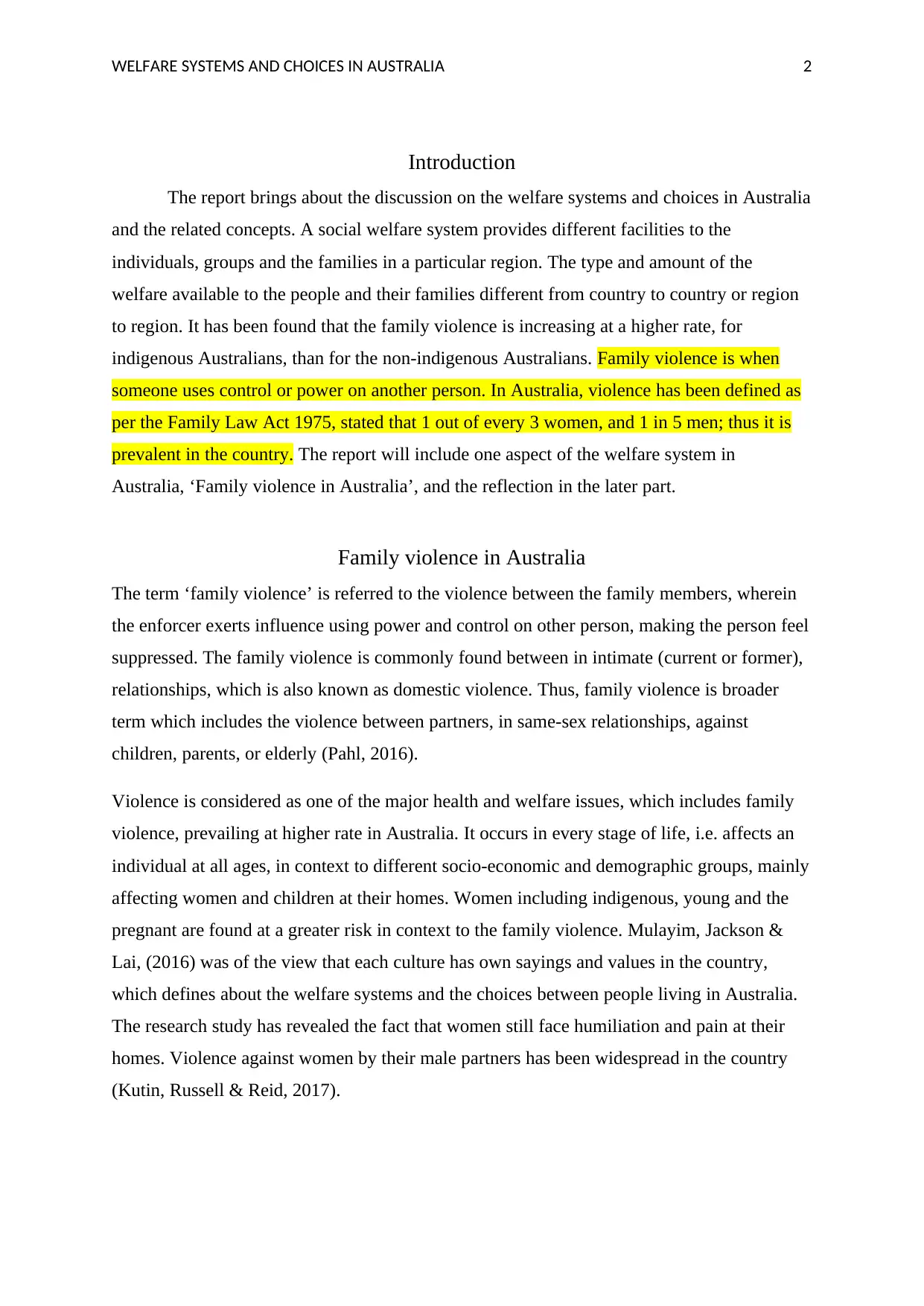
WELFARE SYSTEMS AND CHOICES IN AUSTRALIA 2
Introduction
The report brings about the discussion on the welfare systems and choices in Australia
and the related concepts. A social welfare system provides different facilities to the
individuals, groups and the families in a particular region. The type and amount of the
welfare available to the people and their families different from country to country or region
to region. It has been found that the family violence is increasing at a higher rate, for
indigenous Australians, than for the non-indigenous Australians. Family violence is when
someone uses control or power on another person. In Australia, violence has been defined as
per the Family Law Act 1975, stated that 1 out of every 3 women, and 1 in 5 men; thus it is
prevalent in the country. The report will include one aspect of the welfare system in
Australia, ‘Family violence in Australia’, and the reflection in the later part.
Family violence in Australia
The term ‘family violence’ is referred to the violence between the family members, wherein
the enforcer exerts influence using power and control on other person, making the person feel
suppressed. The family violence is commonly found between in intimate (current or former),
relationships, which is also known as domestic violence. Thus, family violence is broader
term which includes the violence between partners, in same-sex relationships, against
children, parents, or elderly (Pahl, 2016).
Violence is considered as one of the major health and welfare issues, which includes family
violence, prevailing at higher rate in Australia. It occurs in every stage of life, i.e. affects an
individual at all ages, in context to different socio-economic and demographic groups, mainly
affecting women and children at their homes. Women including indigenous, young and the
pregnant are found at a greater risk in context to the family violence. Mulayim, Jackson &
Lai, (2016) was of the view that each culture has own sayings and values in the country,
which defines about the welfare systems and the choices between people living in Australia.
The research study has revealed the fact that women still face humiliation and pain at their
homes. Violence against women by their male partners has been widespread in the country
(Kutin, Russell & Reid, 2017).
Introduction
The report brings about the discussion on the welfare systems and choices in Australia
and the related concepts. A social welfare system provides different facilities to the
individuals, groups and the families in a particular region. The type and amount of the
welfare available to the people and their families different from country to country or region
to region. It has been found that the family violence is increasing at a higher rate, for
indigenous Australians, than for the non-indigenous Australians. Family violence is when
someone uses control or power on another person. In Australia, violence has been defined as
per the Family Law Act 1975, stated that 1 out of every 3 women, and 1 in 5 men; thus it is
prevalent in the country. The report will include one aspect of the welfare system in
Australia, ‘Family violence in Australia’, and the reflection in the later part.
Family violence in Australia
The term ‘family violence’ is referred to the violence between the family members, wherein
the enforcer exerts influence using power and control on other person, making the person feel
suppressed. The family violence is commonly found between in intimate (current or former),
relationships, which is also known as domestic violence. Thus, family violence is broader
term which includes the violence between partners, in same-sex relationships, against
children, parents, or elderly (Pahl, 2016).
Violence is considered as one of the major health and welfare issues, which includes family
violence, prevailing at higher rate in Australia. It occurs in every stage of life, i.e. affects an
individual at all ages, in context to different socio-economic and demographic groups, mainly
affecting women and children at their homes. Women including indigenous, young and the
pregnant are found at a greater risk in context to the family violence. Mulayim, Jackson &
Lai, (2016) was of the view that each culture has own sayings and values in the country,
which defines about the welfare systems and the choices between people living in Australia.
The research study has revealed the fact that women still face humiliation and pain at their
homes. Violence against women by their male partners has been widespread in the country
(Kutin, Russell & Reid, 2017).
⊘ This is a preview!⊘
Do you want full access?
Subscribe today to unlock all pages.

Trusted by 1+ million students worldwide
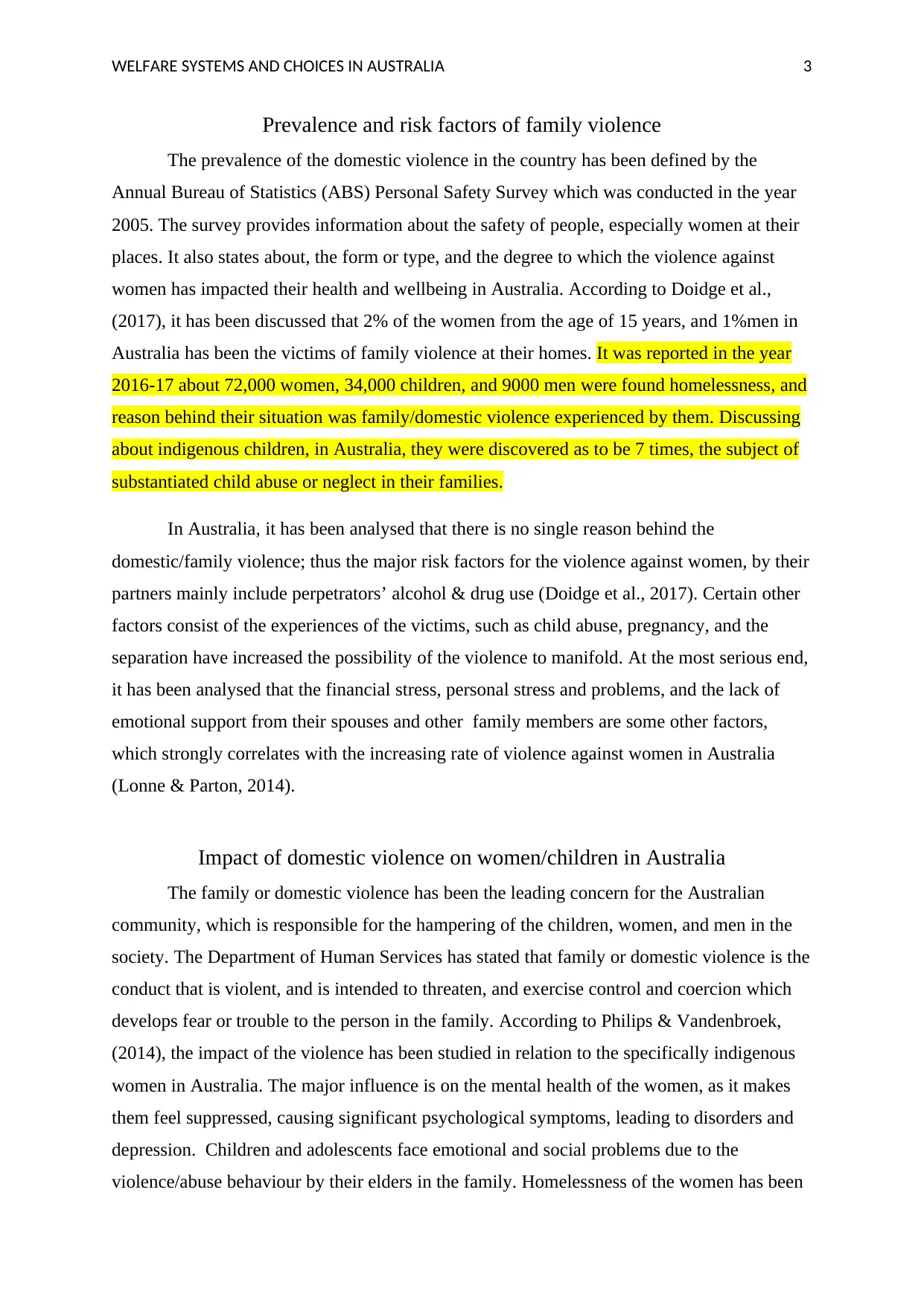
WELFARE SYSTEMS AND CHOICES IN AUSTRALIA 3
Prevalence and risk factors of family violence
The prevalence of the domestic violence in the country has been defined by the
Annual Bureau of Statistics (ABS) Personal Safety Survey which was conducted in the year
2005. The survey provides information about the safety of people, especially women at their
places. It also states about, the form or type, and the degree to which the violence against
women has impacted their health and wellbeing in Australia. According to Doidge et al.,
(2017), it has been discussed that 2% of the women from the age of 15 years, and 1%men in
Australia has been the victims of family violence at their homes. It was reported in the year
2016-17 about 72,000 women, 34,000 children, and 9000 men were found homelessness, and
reason behind their situation was family/domestic violence experienced by them. Discussing
about indigenous children, in Australia, they were discovered as to be 7 times, the subject of
substantiated child abuse or neglect in their families.
In Australia, it has been analysed that there is no single reason behind the
domestic/family violence; thus the major risk factors for the violence against women, by their
partners mainly include perpetrators’ alcohol & drug use (Doidge et al., 2017). Certain other
factors consist of the experiences of the victims, such as child abuse, pregnancy, and the
separation have increased the possibility of the violence to manifold. At the most serious end,
it has been analysed that the financial stress, personal stress and problems, and the lack of
emotional support from their spouses and other family members are some other factors,
which strongly correlates with the increasing rate of violence against women in Australia
(Lonne & Parton, 2014).
Impact of domestic violence on women/children in Australia
The family or domestic violence has been the leading concern for the Australian
community, which is responsible for the hampering of the children, women, and men in the
society. The Department of Human Services has stated that family or domestic violence is the
conduct that is violent, and is intended to threaten, and exercise control and coercion which
develops fear or trouble to the person in the family. According to Philips & Vandenbroek,
(2014), the impact of the violence has been studied in relation to the specifically indigenous
women in Australia. The major influence is on the mental health of the women, as it makes
them feel suppressed, causing significant psychological symptoms, leading to disorders and
depression. Children and adolescents face emotional and social problems due to the
violence/abuse behaviour by their elders in the family. Homelessness of the women has been
Prevalence and risk factors of family violence
The prevalence of the domestic violence in the country has been defined by the
Annual Bureau of Statistics (ABS) Personal Safety Survey which was conducted in the year
2005. The survey provides information about the safety of people, especially women at their
places. It also states about, the form or type, and the degree to which the violence against
women has impacted their health and wellbeing in Australia. According to Doidge et al.,
(2017), it has been discussed that 2% of the women from the age of 15 years, and 1%men in
Australia has been the victims of family violence at their homes. It was reported in the year
2016-17 about 72,000 women, 34,000 children, and 9000 men were found homelessness, and
reason behind their situation was family/domestic violence experienced by them. Discussing
about indigenous children, in Australia, they were discovered as to be 7 times, the subject of
substantiated child abuse or neglect in their families.
In Australia, it has been analysed that there is no single reason behind the
domestic/family violence; thus the major risk factors for the violence against women, by their
partners mainly include perpetrators’ alcohol & drug use (Doidge et al., 2017). Certain other
factors consist of the experiences of the victims, such as child abuse, pregnancy, and the
separation have increased the possibility of the violence to manifold. At the most serious end,
it has been analysed that the financial stress, personal stress and problems, and the lack of
emotional support from their spouses and other family members are some other factors,
which strongly correlates with the increasing rate of violence against women in Australia
(Lonne & Parton, 2014).
Impact of domestic violence on women/children in Australia
The family or domestic violence has been the leading concern for the Australian
community, which is responsible for the hampering of the children, women, and men in the
society. The Department of Human Services has stated that family or domestic violence is the
conduct that is violent, and is intended to threaten, and exercise control and coercion which
develops fear or trouble to the person in the family. According to Philips & Vandenbroek,
(2014), the impact of the violence has been studied in relation to the specifically indigenous
women in Australia. The major influence is on the mental health of the women, as it makes
them feel suppressed, causing significant psychological symptoms, leading to disorders and
depression. Children and adolescents face emotional and social problems due to the
violence/abuse behaviour by their elders in the family. Homelessness of the women has been
Paraphrase This Document
Need a fresh take? Get an instant paraphrase of this document with our AI Paraphraser
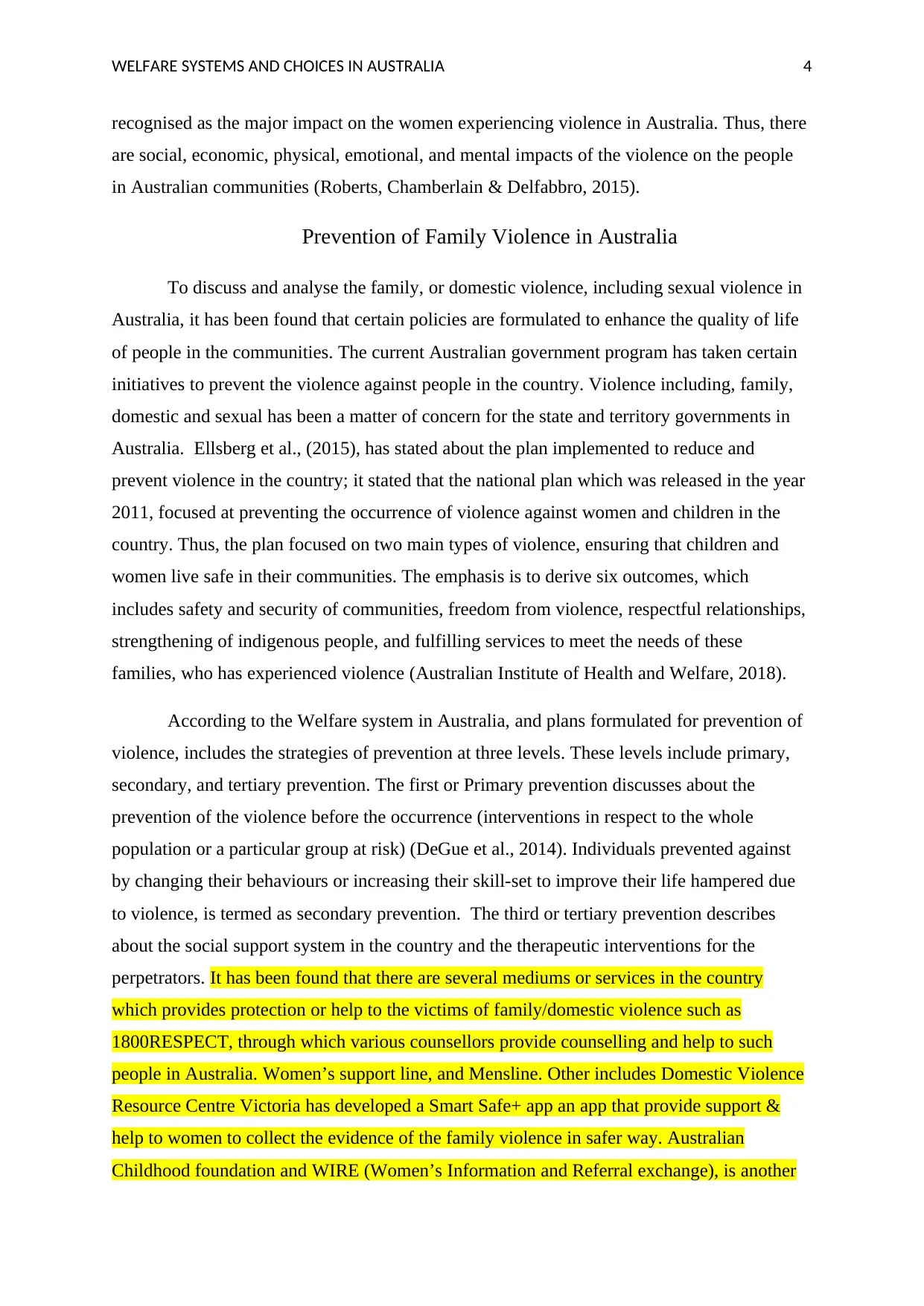
WELFARE SYSTEMS AND CHOICES IN AUSTRALIA 4
recognised as the major impact on the women experiencing violence in Australia. Thus, there
are social, economic, physical, emotional, and mental impacts of the violence on the people
in Australian communities (Roberts, Chamberlain & Delfabbro, 2015).
Prevention of Family Violence in Australia
To discuss and analyse the family, or domestic violence, including sexual violence in
Australia, it has been found that certain policies are formulated to enhance the quality of life
of people in the communities. The current Australian government program has taken certain
initiatives to prevent the violence against people in the country. Violence including, family,
domestic and sexual has been a matter of concern for the state and territory governments in
Australia. Ellsberg et al., (2015), has stated about the plan implemented to reduce and
prevent violence in the country; it stated that the national plan which was released in the year
2011, focused at preventing the occurrence of violence against women and children in the
country. Thus, the plan focused on two main types of violence, ensuring that children and
women live safe in their communities. The emphasis is to derive six outcomes, which
includes safety and security of communities, freedom from violence, respectful relationships,
strengthening of indigenous people, and fulfilling services to meet the needs of these
families, who has experienced violence (Australian Institute of Health and Welfare, 2018).
According to the Welfare system in Australia, and plans formulated for prevention of
violence, includes the strategies of prevention at three levels. These levels include primary,
secondary, and tertiary prevention. The first or Primary prevention discusses about the
prevention of the violence before the occurrence (interventions in respect to the whole
population or a particular group at risk) (DeGue et al., 2014). Individuals prevented against
by changing their behaviours or increasing their skill-set to improve their life hampered due
to violence, is termed as secondary prevention. The third or tertiary prevention describes
about the social support system in the country and the therapeutic interventions for the
perpetrators. It has been found that there are several mediums or services in the country
which provides protection or help to the victims of family/domestic violence such as
1800RESPECT, through which various counsellors provide counselling and help to such
people in Australia. Women’s support line, and Mensline. Other includes Domestic Violence
Resource Centre Victoria has developed a Smart Safe+ app an app that provide support &
help to women to collect the evidence of the family violence in safer way. Australian
Childhood foundation and WIRE (Women’s Information and Referral exchange), is another
recognised as the major impact on the women experiencing violence in Australia. Thus, there
are social, economic, physical, emotional, and mental impacts of the violence on the people
in Australian communities (Roberts, Chamberlain & Delfabbro, 2015).
Prevention of Family Violence in Australia
To discuss and analyse the family, or domestic violence, including sexual violence in
Australia, it has been found that certain policies are formulated to enhance the quality of life
of people in the communities. The current Australian government program has taken certain
initiatives to prevent the violence against people in the country. Violence including, family,
domestic and sexual has been a matter of concern for the state and territory governments in
Australia. Ellsberg et al., (2015), has stated about the plan implemented to reduce and
prevent violence in the country; it stated that the national plan which was released in the year
2011, focused at preventing the occurrence of violence against women and children in the
country. Thus, the plan focused on two main types of violence, ensuring that children and
women live safe in their communities. The emphasis is to derive six outcomes, which
includes safety and security of communities, freedom from violence, respectful relationships,
strengthening of indigenous people, and fulfilling services to meet the needs of these
families, who has experienced violence (Australian Institute of Health and Welfare, 2018).
According to the Welfare system in Australia, and plans formulated for prevention of
violence, includes the strategies of prevention at three levels. These levels include primary,
secondary, and tertiary prevention. The first or Primary prevention discusses about the
prevention of the violence before the occurrence (interventions in respect to the whole
population or a particular group at risk) (DeGue et al., 2014). Individuals prevented against
by changing their behaviours or increasing their skill-set to improve their life hampered due
to violence, is termed as secondary prevention. The third or tertiary prevention describes
about the social support system in the country and the therapeutic interventions for the
perpetrators. It has been found that there are several mediums or services in the country
which provides protection or help to the victims of family/domestic violence such as
1800RESPECT, through which various counsellors provide counselling and help to such
people in Australia. Women’s support line, and Mensline. Other includes Domestic Violence
Resource Centre Victoria has developed a Smart Safe+ app an app that provide support &
help to women to collect the evidence of the family violence in safer way. Australian
Childhood foundation and WIRE (Women’s Information and Referral exchange), is another
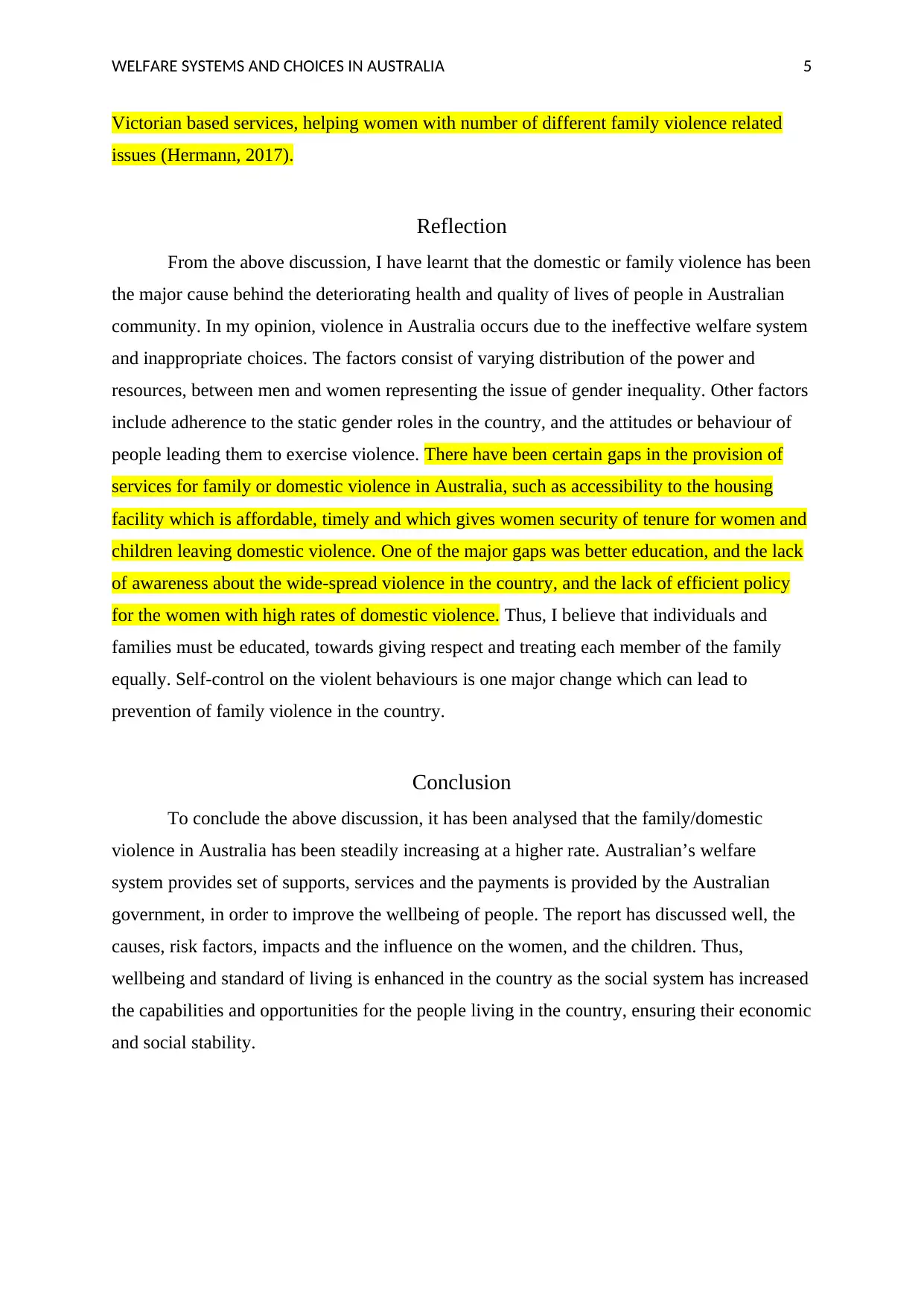
WELFARE SYSTEMS AND CHOICES IN AUSTRALIA 5
Victorian based services, helping women with number of different family violence related
issues (Hermann, 2017).
Reflection
From the above discussion, I have learnt that the domestic or family violence has been
the major cause behind the deteriorating health and quality of lives of people in Australian
community. In my opinion, violence in Australia occurs due to the ineffective welfare system
and inappropriate choices. The factors consist of varying distribution of the power and
resources, between men and women representing the issue of gender inequality. Other factors
include adherence to the static gender roles in the country, and the attitudes or behaviour of
people leading them to exercise violence. There have been certain gaps in the provision of
services for family or domestic violence in Australia, such as accessibility to the housing
facility which is affordable, timely and which gives women security of tenure for women and
children leaving domestic violence. One of the major gaps was better education, and the lack
of awareness about the wide-spread violence in the country, and the lack of efficient policy
for the women with high rates of domestic violence. Thus, I believe that individuals and
families must be educated, towards giving respect and treating each member of the family
equally. Self-control on the violent behaviours is one major change which can lead to
prevention of family violence in the country.
Conclusion
To conclude the above discussion, it has been analysed that the family/domestic
violence in Australia has been steadily increasing at a higher rate. Australian’s welfare
system provides set of supports, services and the payments is provided by the Australian
government, in order to improve the wellbeing of people. The report has discussed well, the
causes, risk factors, impacts and the influence on the women, and the children. Thus,
wellbeing and standard of living is enhanced in the country as the social system has increased
the capabilities and opportunities for the people living in the country, ensuring their economic
and social stability.
Victorian based services, helping women with number of different family violence related
issues (Hermann, 2017).
Reflection
From the above discussion, I have learnt that the domestic or family violence has been
the major cause behind the deteriorating health and quality of lives of people in Australian
community. In my opinion, violence in Australia occurs due to the ineffective welfare system
and inappropriate choices. The factors consist of varying distribution of the power and
resources, between men and women representing the issue of gender inequality. Other factors
include adherence to the static gender roles in the country, and the attitudes or behaviour of
people leading them to exercise violence. There have been certain gaps in the provision of
services for family or domestic violence in Australia, such as accessibility to the housing
facility which is affordable, timely and which gives women security of tenure for women and
children leaving domestic violence. One of the major gaps was better education, and the lack
of awareness about the wide-spread violence in the country, and the lack of efficient policy
for the women with high rates of domestic violence. Thus, I believe that individuals and
families must be educated, towards giving respect and treating each member of the family
equally. Self-control on the violent behaviours is one major change which can lead to
prevention of family violence in the country.
Conclusion
To conclude the above discussion, it has been analysed that the family/domestic
violence in Australia has been steadily increasing at a higher rate. Australian’s welfare
system provides set of supports, services and the payments is provided by the Australian
government, in order to improve the wellbeing of people. The report has discussed well, the
causes, risk factors, impacts and the influence on the women, and the children. Thus,
wellbeing and standard of living is enhanced in the country as the social system has increased
the capabilities and opportunities for the people living in the country, ensuring their economic
and social stability.
⊘ This is a preview!⊘
Do you want full access?
Subscribe today to unlock all pages.

Trusted by 1+ million students worldwide
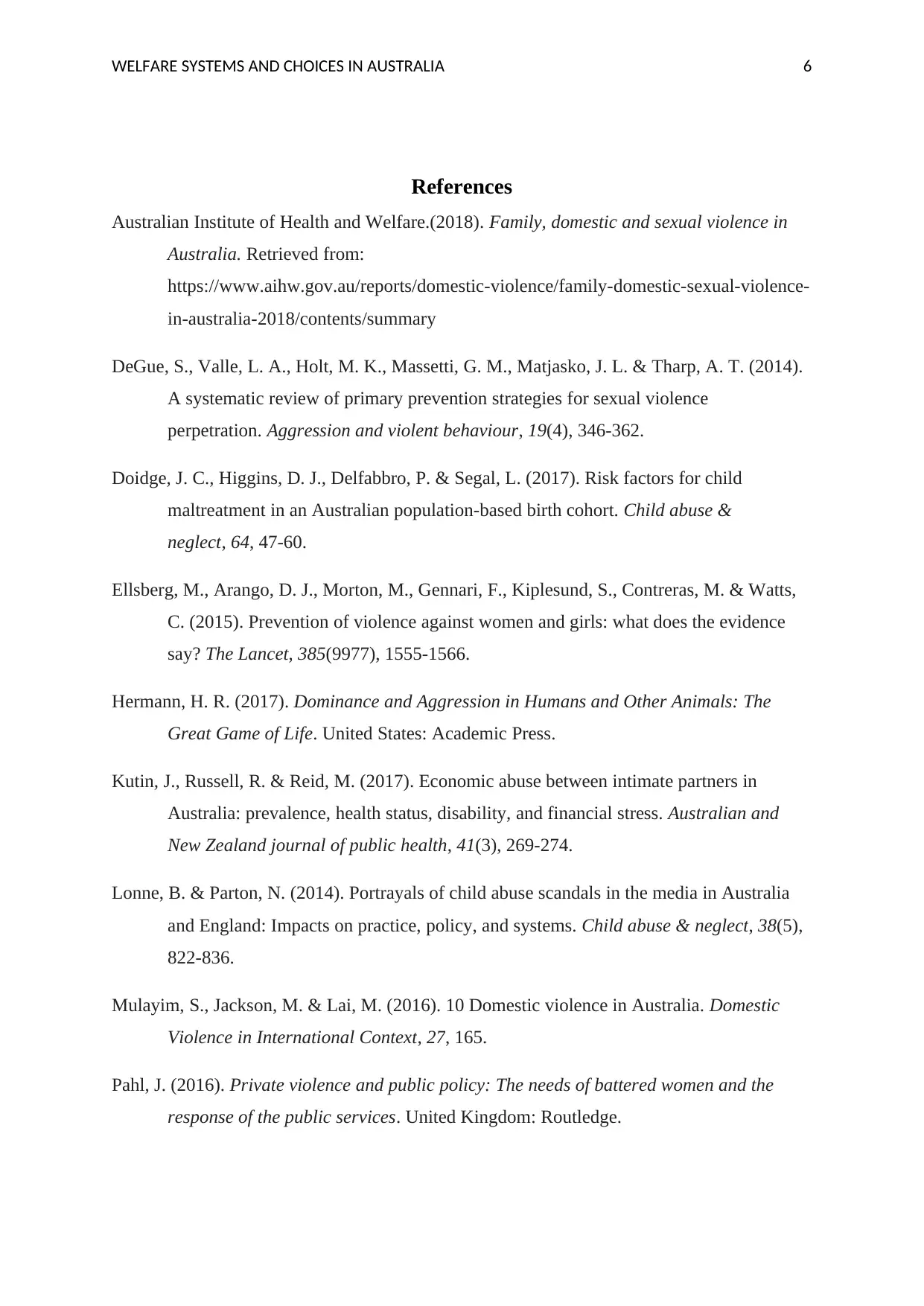
WELFARE SYSTEMS AND CHOICES IN AUSTRALIA 6
References
Australian Institute of Health and Welfare.(2018). Family, domestic and sexual violence in
Australia. Retrieved from:
https://www.aihw.gov.au/reports/domestic-violence/family-domestic-sexual-violence-
in-australia-2018/contents/summary
DeGue, S., Valle, L. A., Holt, M. K., Massetti, G. M., Matjasko, J. L. & Tharp, A. T. (2014).
A systematic review of primary prevention strategies for sexual violence
perpetration. Aggression and violent behaviour, 19(4), 346-362.
Doidge, J. C., Higgins, D. J., Delfabbro, P. & Segal, L. (2017). Risk factors for child
maltreatment in an Australian population-based birth cohort. Child abuse &
neglect, 64, 47-60.
Ellsberg, M., Arango, D. J., Morton, M., Gennari, F., Kiplesund, S., Contreras, M. & Watts,
C. (2015). Prevention of violence against women and girls: what does the evidence
say? The Lancet, 385(9977), 1555-1566.
Hermann, H. R. (2017). Dominance and Aggression in Humans and Other Animals: The
Great Game of Life. United States: Academic Press.
Kutin, J., Russell, R. & Reid, M. (2017). Economic abuse between intimate partners in
Australia: prevalence, health status, disability, and financial stress. Australian and
New Zealand journal of public health, 41(3), 269-274.
Lonne, B. & Parton, N. (2014). Portrayals of child abuse scandals in the media in Australia
and England: Impacts on practice, policy, and systems. Child abuse & neglect, 38(5),
822-836.
Mulayim, S., Jackson, M. & Lai, M. (2016). 10 Domestic violence in Australia. Domestic
Violence in International Context, 27, 165.
Pahl, J. (2016). Private violence and public policy: The needs of battered women and the
response of the public services. United Kingdom: Routledge.
References
Australian Institute of Health and Welfare.(2018). Family, domestic and sexual violence in
Australia. Retrieved from:
https://www.aihw.gov.au/reports/domestic-violence/family-domestic-sexual-violence-
in-australia-2018/contents/summary
DeGue, S., Valle, L. A., Holt, M. K., Massetti, G. M., Matjasko, J. L. & Tharp, A. T. (2014).
A systematic review of primary prevention strategies for sexual violence
perpetration. Aggression and violent behaviour, 19(4), 346-362.
Doidge, J. C., Higgins, D. J., Delfabbro, P. & Segal, L. (2017). Risk factors for child
maltreatment in an Australian population-based birth cohort. Child abuse &
neglect, 64, 47-60.
Ellsberg, M., Arango, D. J., Morton, M., Gennari, F., Kiplesund, S., Contreras, M. & Watts,
C. (2015). Prevention of violence against women and girls: what does the evidence
say? The Lancet, 385(9977), 1555-1566.
Hermann, H. R. (2017). Dominance and Aggression in Humans and Other Animals: The
Great Game of Life. United States: Academic Press.
Kutin, J., Russell, R. & Reid, M. (2017). Economic abuse between intimate partners in
Australia: prevalence, health status, disability, and financial stress. Australian and
New Zealand journal of public health, 41(3), 269-274.
Lonne, B. & Parton, N. (2014). Portrayals of child abuse scandals in the media in Australia
and England: Impacts on practice, policy, and systems. Child abuse & neglect, 38(5),
822-836.
Mulayim, S., Jackson, M. & Lai, M. (2016). 10 Domestic violence in Australia. Domestic
Violence in International Context, 27, 165.
Pahl, J. (2016). Private violence and public policy: The needs of battered women and the
response of the public services. United Kingdom: Routledge.
Paraphrase This Document
Need a fresh take? Get an instant paraphrase of this document with our AI Paraphraser
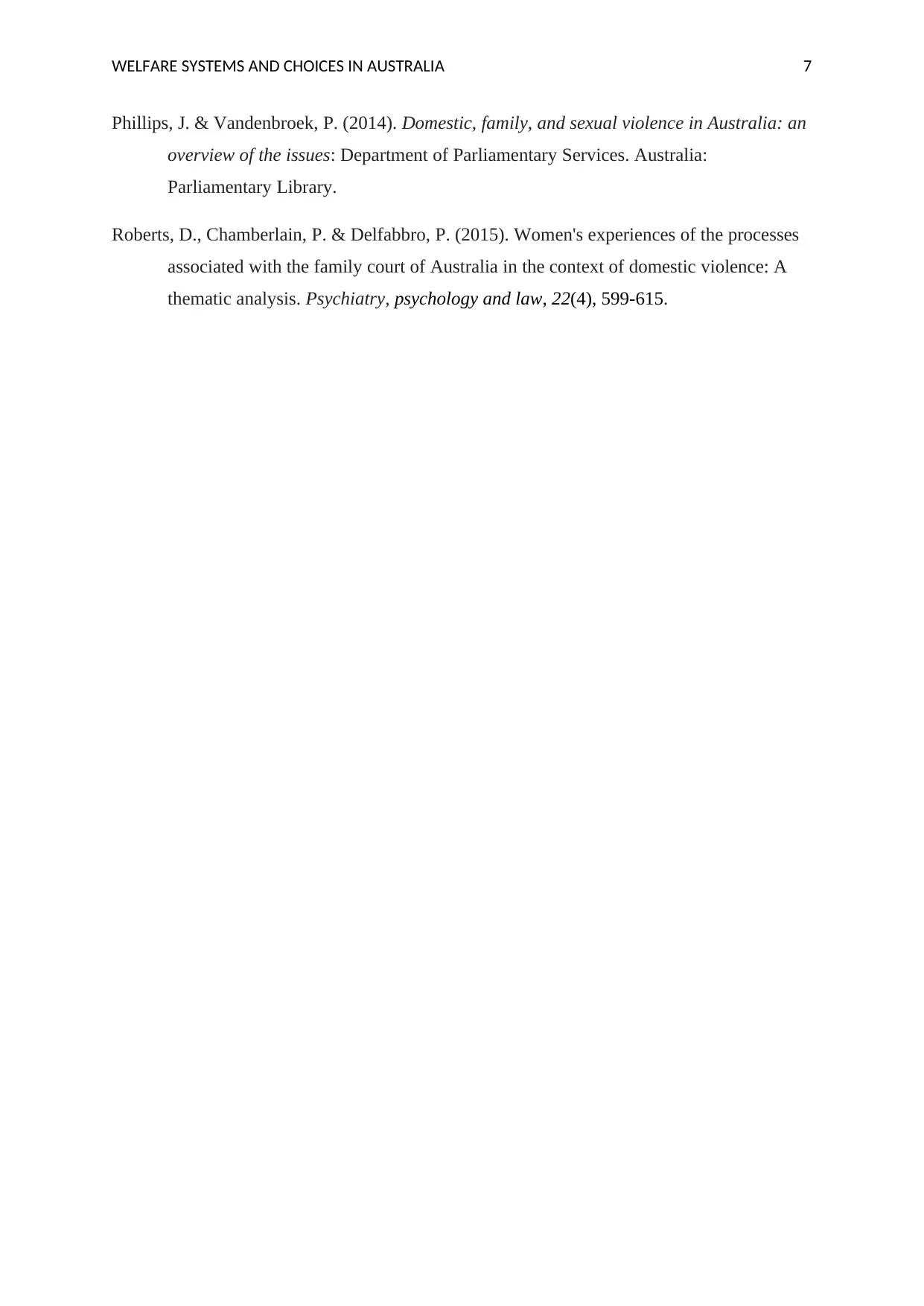
WELFARE SYSTEMS AND CHOICES IN AUSTRALIA 7
Phillips, J. & Vandenbroek, P. (2014). Domestic, family, and sexual violence in Australia: an
overview of the issues: Department of Parliamentary Services. Australia:
Parliamentary Library.
Roberts, D., Chamberlain, P. & Delfabbro, P. (2015). Women's experiences of the processes
associated with the family court of Australia in the context of domestic violence: A
thematic analysis. Psychiatry, psychology and law, 22(4), 599-615.
Phillips, J. & Vandenbroek, P. (2014). Domestic, family, and sexual violence in Australia: an
overview of the issues: Department of Parliamentary Services. Australia:
Parliamentary Library.
Roberts, D., Chamberlain, P. & Delfabbro, P. (2015). Women's experiences of the processes
associated with the family court of Australia in the context of domestic violence: A
thematic analysis. Psychiatry, psychology and law, 22(4), 599-615.
1 out of 8
Related Documents
Your All-in-One AI-Powered Toolkit for Academic Success.
+13062052269
info@desklib.com
Available 24*7 on WhatsApp / Email
![[object Object]](/_next/static/media/star-bottom.7253800d.svg)
Unlock your academic potential
Copyright © 2020–2025 A2Z Services. All Rights Reserved. Developed and managed by ZUCOL.





